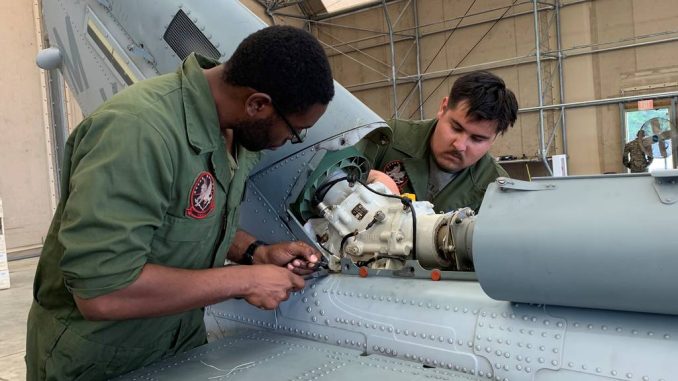
Marines in Florida recently test fired an air-to-ground missile from an AH-1Z Viper helicopter, part of the Corps’ push to upgrade its aviation fleet for great power competition and a new way for Leathernecks to fight.
Marines with the Operational Test and Evaluation Squadron 1, or VMX-1, did the joint test with Air Force and Army personnel at Eglin Air Force Base, Florida, between Nov. 3–7, according to a Marine statement.
The test is expected to help upgrade the Viper and UH-1Y Venom helicopters for better maritime targeting and strikes.
The new weapons system could give attack helicopter pilots newer munitions, “equipped with two sensor technologies” that optimize performance on maritime targets, according to the statement.
RELATED
:quality(70)/cloudfront-us-east-1.images.arcpublishing.com/mco/QLYZQ63C2ZB2ZGXFQYUYU5UU2Y.jpg)
Marines from Air Test and Evaluation Squadron Two One, or HX-21, working under the Naval Air Systems Command Direct and Time Sensitive Strike program office, Army Program Executive Office Missiles and Space and the Air Force’s 780th Test Squadron analyzed the test fire.
Col. Byron Sullivan, VMX-1 commanding officer, called the joint test fire a “phenomenal experience” and said the capability “will be the needed upgrade that enhances our ability to use precision strikes against fast-moving maritime targets.”
“Executing this type of concept development is very critical to get it right on paper and put more effective systems in the hands of the warfighter,” said Maj. Thomas Hutson, the assault support department head at VMX-1 and member of the JAGM test team.
Marine Corps Times recently reported that the Corps has reactivated an air wing support squadron at Marine Corps Base Hawaii after a 27-year hiatus. Marine Wing Support Squadron 174, the “Gryphons” and expect the unit to be fully operational by 2023.
Improving and reconfiguring aviation units, personnel and platforms is one part of the larger plan that Marine Corps Commandant Gen. David Berger is driving through force design changes.
That is to expand the Marine Air Wing’s “reach and lethality in support of maritime and joint operations,” so that it can operate dispersed and in unsupported terrain, according to a November release.
As the Corps keeps current aviation platforms ready for today’s demands, the Corps, Army and Special Operations Command are also looking to new rotary wing development to increase range, speed and payload.
Marine Corps Times reported in 2019 that the Army’s Future Vertical Lift program aimed to replace the UH-60 Black Hawk for the Army and the UH-1Y Venom for the Marines with the future long range attack aircraft, or FLRAA.
The maximum speeds for the Venom and Black Hawk now stand at about 180–190 miles per hour with a full payload. The FLRAA is expected to fly at 265 mph to 322 mph.
There are some differences in the needs of the services, however. The Army’s requirements would vastly improve current performance and add range to their fleet.
An example listed in the federal “sources sought” posting was for self-deployment. That’s stripped down to crew and equipment, allowing pilots to travel between 2,000 and 2,800 miles one way.
And there’s a reason for those requirements.
“The self-deployment mission represents standard long-range overwater planning for the longest segment of the shortest possible route across the Pacific Ocean, which is from Eareckson (Air Station), Alaksa (in the Aleutian Island chain) to Chitose, Japan,” according to the 2019 posting.
Todd South has written about crime, courts, government and the military for multiple publications since 2004 and was named a 2014 Pulitzer finalist for a co-written project on witness intimidation. Todd is a Marine veteran of the Iraq War.



Be the first to comment